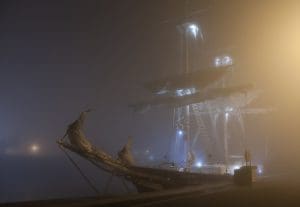December 4, 2022 marks the 150th anniversary of the discovery of the Mary Celeste, a ship found floating in the Atlantic Ocean off the coast of Portugal, with no crew or passengers on board. The fate of the seven crewmen and three passengers remains a mystery to this day. Over the years, several theories have been advanced. Were the crewmen kidnapped by pirates? Were they forced to abandon ship in a storm? Did the crew revolt against the captain?
The Mary Celeste was first noticed drifting by a passing ship, the British Dei Gratia, which sailed the same route. Dei Gratia's crewmen found that the brigantine's one lifeboat was missing, and most of her cargo of industrial alcohol was intact. A six-month supply of food remained. The Mary Celeste became a legend of shipping folklore, emblematic of the public's fascination with mysterious disappearances and disaster at sea. Here are some books which examine the eerie phenomena of ghost ships and shipwrecks.
The story of how the Mary Celeste came to be known as cursed even before her fateful voyage in 1872 is detailed in Brian Hicks's Ghost Ship, which dives deep into her history. Hicks reveals multiple misfortunes suffered by the ship, including her captain dying before her maiden voyage and a storm causing her crew to abandon ship in Cape Breton.
Two ghost ships, part of the Franklin Expedition, have inspired nonfiction as well as fiction accounts. For centuries, starting with Columbus in 1492, exploratory expeditions were planned to find a shipping route, known as the Northwest Passage, that would connect the Atlantic Ocean to the Pacific via a Canadian archipelago in the Arctic. Many past expeditions had discovered pieces of the route, but parts of it remained unknown due to the arduousness of the journey through frigid arctic ice. Paul Watson's Ice Ghosts describes the journey of The Terror and Erebus, well-provisioned and manned ships which set out in 1845 from England determined to discover the remaining pieces of the Northwest passage. Instead, the two ships got stuck in the ice. The surviving crew made it to the Canadian mainland, but all 129 eventually perished before returning. Evidence of their final days told a harrowing tale.
Dan Simmons's genre-blending historical horror story The Terror is a fictional account of the Franklin Expedition. Incorporating supernatural elements, it depicts the rapid descent from the optimistic early days of the voyage on the two newly invented steamships into a hellscape of diminishing rations, frigid cold and ice and desperate measures to survive. The series has been adapted into an AMC TV series, also titled The Terror.
Martin W. Sandler's Resolute describes the ill-fated trek undertaken by the English in 1854 to find and rescue the crew of The Terror and Erebus after they failed to return from their Arctic voyage. When the Resolute herself became trapped in sea ice, the captain and crew abandoned her. Found a year later near Connecticut after drifting 1200 miles, the ship was returned to England, decommissioned and eventually taken apart. The Resolute desk in the White House is made of oak timbers from the disassembled Resolute.
Ian Urbina's The Outlaw Ocean, which began as a series of articles in the New York Times in 2015 and is supported by a recent podcast, describes the difficulty of prosecuting crimes committed at sea, where oversight and regulation are rare. In 2015, battered ghost boats began to be seen drifting through the Sea of Japan and started to wash up on the coast of South Korea, sometimes with corpses on board. Urbina investigated and in 2020 reported the ghost boats to be North Korean fishing boats forced off course into dangerous waters by the proliferation of Chinese fishing boats venturing illegally into North Korean waters.
Those interested in the history of the merchant marine and the hazards of working on the container ships we rely on to transport the goods we buy and use every day will be riveted by Rachel Slade's Into the Raging Sea, which describes the tragedy of the container ship El Faro, which sailed into the eye of hurricane Joaquin and sank in 2015, the lives of all 33 crew members lost. Impeccably researched, the book includes interviews with families of the survivors and stories from coast guard rescuers and past crew members. An investigation by the Coast Guard and the NTSB revealed that faulty communication, poor decisions on the part of the ship master, a 9-hour delay in weather-reporting software, and poor maintenance of the ship led to the sinking.




Add a comment to: Ghost Ships: 150th Anniversary of the Discovery of the Mary Celeste